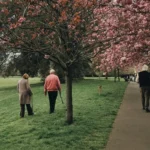In our fast-paced world, stress has become an ongoing reality for many. While there are countless ways to unwind, few methods offer as immediate and profound a sense of relief as a good massage. The secret behind this blissful relaxation lies in the intricate workings of the body particularly in how massage stimulates the parasympathetic nervous system (PNS). In this article, we’ll explore the fascinating science behind massage therapy and its effects on the PNS, shedding light on why and how it makes you feel so incredibly relaxed.
UNDERSTANDING THE NERVOUS SYSTEM
To understand how massage impacts your body, it helps first to know how the autonomic nervous system works. This system controls involuntary functions such as breathing, heartbeat, and digestion and is divided into two branches: the sympathetic and parasympathetic systems.
• Sympathetic Nervous System (SNS): Often referred to as the “fight or flight” system, the SNS prepares your body to deal with stress. It increases heart rate, elevates blood pressure, and boosts adrenaline production enabling you to react swiftly to immediate threats.
• Parasympathetic Nervous System (PNS): In contrast, the PNS known as the “rest and digest” system calms the body after a stressful event. It slows heart rate, stimulates digestion, and promotes relaxation and recovery.
Therefore, when you receive a massage, the techniques used can gently shift your body from a stressed state controlled by the sympathetic nervous system (SNS) to a calm, relaxed state controlled by the parasympathetic nervous system (PNS).
A TRADITION ROOTED IN ANCIENT HEALING
Interestingly, the soothing power of massage isn’t a modern discovery it’s a practice deeply rooted in ancient healing traditions. Thousands of years before modern medicine, civilizations in China, Egypt, and India recognized the restorative potential of touch. For instance, Ayurvedic medicine in India emphasized Abhyanga a daily oil massage believed to balance energy and strengthen immunity. Similarly, ancient Egyptian tomb paintings depict massage as part of health rituals, while Hippocrates, the father of modern medicine, famously advised, “The physician must be experienced in many things, but assuredly in rubbing.”
These early practices were based on instinct and observation. Today, however, modern neuroscience validates what ancient healers already sensed that rhythmic, intentional touch can profoundly influence the nervous system, fostering relaxation, balance, and healing.
THE SCIENCE BEHIND MASSAGE AND RELAXATION
As science advanced, researchers began uncovering the mechanisms behind these age-old benefits. Numerous studies now confirm that massage therapy triggers measurable physiological changes that promote relaxation.
A 2023 review in Frontiers in Psychology found that massage activates neural pathways associated with vagal (vagus nerve) stimulation. This, in turn, lowers stress biomarkers like cortisol and enhances heart rate variability (HRV) a reliable indicator of parasympathetic activation.
In simpler terms, massage gently tells your nervous system, “You’re safe now slow down and recover.”
SIMULATING THE PARASYMPATHETIC NERVOUS SYSTEM
Massage therapy engages the PNS in several interconnected ways, each contributing to the deep sense of calm you experience afterward.
1. Activation of the Vagus Nerve
To begin with, the vagus nerves a vital component of the PNS acts as a communication bridge between the brain and major organs. When gentle, rhythmic pressure is applied during massage, it stimulates this nerve, triggering a cascade of calming responses.
According to studies published in Autonomic Neuroscience and Complementary Therapies in Medicine, this stimulation leads to decreased heart rate and blood pressure, both clear signs of improved vagal tone and relaxation.
2. Decreased Cortisol Levels
Furthermore, massage helps counteract stress by lowering levels of cortisol, the body’s main stress hormone.
A meta-analysis in the Journal of Alternative and Complementary Medicine (2010) found that people who received regular massages experienced an average 31% reduction in cortisol, along with increases in serotonin and dopamine key neurotransmitters that stabilize mood and foster relaxation.
This biochemical shift effectively rebalances your internal chemistry, signaling the body that the stressful episode has passed.
3. Release of Neurotransmitters
Additionally, massage promotes the release of feel-good chemicals such as serotonin and dopamine, both essential for emotional balance and happiness.
A 2021 study in Evidence-Based Complementary and Alternative Medicine showed that these neurotransmitter boosts contribute to improved mood, better focus, and a sense of emotional well-being. It’s no surprise that many people report feeling lighter and more optimistic after a session.
4. Muscle Tension Relief
Lastly, by loosening tight muscles and easing knots, massage relieves physical discomfort that can feed into mental stress. Reduced muscle tension also lowers levels of substance P, a neurotransmitter involved in pain perception. As the body relaxes, the brain interprets this release as safety further strengthening parasympathetic dominance and overall calm.
PSYCHOLOGICAL BENEFITS
Beyond its physiological impact, massage profoundly influences the mind.
1. Mindfulness and Presence:
During a massage, you naturally focus on physical sensations the warmth of hands, the rhythm of strokes, the release of tension. This mindfulness pulls attention away from intrusive thoughts and helps the brain enter a meditative state.
Research in Frontiers in Human Neuroscience suggests that such mindful touch increases activity in the insula, a brain region responsible for body awareness and emotional regulation.
2. Emotional Release:
Moreover, massage encourages the release of oxytocin, often called the “bonding hormone.” Elevated oxytocin levels foster trust, ease anxiety, and even bring about emotional release. This explains why people often leave a massage not only physically relaxed but also emotionally lighter.
3. Improved Sleep:
Finally, relaxation continues beyond the massage table. Regular sessions have been shown to improve sleep quality by increasing melatonin production.
A 2020 clinical trial in Sleep Science found that participants receiving weekly massages fell asleep faster and experienced deeper, more restorative sleep a key factor in long-term stress recovery.
PRACTICAL APPLICATIONS: HOW TO USE MASSAGE FOR RELAXATION
Given its wide-ranging effects on both body and mind, massage can be a powerful tool in your self-care toolkit. To benefit the most from it, be regular and mindful.
First, work with a qualified massage therapist who understands different modalities. Techniques such as Swedish massage, lymphatic drainage, and aromatherapy massage are particularly effective in promoting relaxation and improving vagal tone.
Next, aim to make massage a routine rather than a rare luxury. Whether once a week or once a month, regular sessions help train your nervous system to more easily switch into a parasympathetic, healing mode.
If scheduling professional sessions isn’t always possible, self-massage can be surprisingly beneficial. Using a foam roller, massage ball, or even gentle pressure from your own hands can ease muscle tension and activate the same calming pathways.
Additionally, combining massage with aromatherapy using oils such as lavender, chamomile, or bergamot can enhance relaxation. These scents have been shown to further stimulate parasympathetic responses and improve mood.
Finally, incorporate mindful breathing during massage. By synchronizing your breath with each stroke, you can deepen relaxation and reinforce the brain-body connection.
CONCLUSION
In essence, massage therapy is far more than a luxury it’s a scientifically validated practice that restores balance to the nervous system. By stimulating the parasympathetic nervous system, massage effectively counteracts the body’s stress-driven “fight or flight” response, leading to a cascade of physiological and psychological benefits.
From lowering cortisol and blood pressure to enhancing serotonin, dopamine, and oxytocin levels, the evidence is clear: massage helps the body remember how to relax.
Whether you choose professional therapy or practice simple self-massage at home, this ancient-yet-scientifically grounded ritual offers a powerful reminder that relaxation is not just indulgence its biology in harmony. Prioritizing it can help you meet life’s challenges with greater strength, balance, and peace.
FAQs About Massage and the Parasympathetic Nervous System
1. How long does it take for massage to activate the parasympathetic nervous system?
The parasympathetic response can begin within minutes of starting a massage. Most people experience a noticeable drop-in heart rate and muscle tension during the first 10–15 minutes as the body shifts into relaxation mode.
2. Can self-massage produce the same effects as professional massage?
Yes, to some extent. While professional massage offers deeper and more targeted techniques, self-massage especially when combined with slow breathing can still help stimulate vagal tone and reduce stress.
3. What type of massage is best for relaxation and nervous system balance?
Gentle techniques such as Swedish massage, Aromatherapy massage, or Lymphatic drainage are best for activating the parasympathetic nervous system. These involve smooth, rhythmic strokes that calm both the body and mind.
4. How often should I get a massage to manage stress effectively?
Consistency matters more than intensity. Even one session every two to four weeks can lead to measurable reductions in cortisol and improvements in mood and sleep quality.
5. Are there any conditions where massage should be avoided?
Massage may not be suitable for individuals with acute infections, blood clots, skin infections, or certain cardiovascular disorders. Always consult your healthcare provider before beginning massage therapy if you have any underlying medical condition.
DISCLAIMER
This article is for educational purposes only and should not be considered medical advice. Always consult a qualified healthcare professional or licensed massage therapist before starting any new treatment or therapy, especially if you have a chronic illness, injury, or medical condition.
CALL TO ACTION
Ready to experience the calming power of massage?
Make relaxation a part of your self-care routine book a session with a certified massage therapist or try simple self-massage at home to restore your body’s natural balance.
Your nervous system and your peace of mind will thank you.
REFERENCE’S
1. Field, T. (2010). Massage therapy research review. Complementary Therapies in Clinical Practice, 16(4), 224–229.
2. Diego, M. A., & Field, T. (2009). Moderate pressure massage elicits parasympathetic nervous system responses. International Journal of Neuroscience, 119(5), 630–638.
3. Morhenn, V. B., Beavin, L. E., & Zak, P. J. (2012). Massage increases oxytocin and reduces adrenocorticotropin hormone in humans. Alternative Therapies in Health and Medicine, 18(6), 11–18.
4. Field, T., Diego, M., & Hernandez-Reif, M. (2020). Massage therapy research review update. Complementary Therapies in Clinical Practice, 39, 101–105.
5. Uvnäs-Moberg, K., Handlin, L., & Petersson, M. (2015). Self-soothing behaviors with particular reference to oxytocin release induced by non-noxious sensory stimulation. Frontiers in Psychology, 5, 1529.
6. Moyer, C. A., Rounds, J., & Hannum, J. W. (2004). A meta-analysis of massage therapy research. Psychological Bulletin, 130(1), 3–18. 7. Cidral-Filho, F. J., et al. (2021). Massage therapy and autonomic nervous system modulation: A systematic review. Frontiers in Psychology, 12, 715–728.




